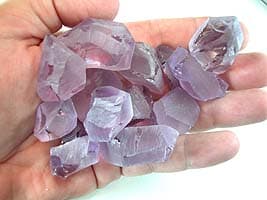Choosing Your First Gemstones: A Rough Guide for Faceters
How should novice faceters choose their first gemstones? Learn which gem rough materials combine cutting ease, low cost, good size, and profit potential.
1 Minute Read
First Gemstones: Beryls
When pale colored or colorless, beryls are also inexpensive and fairly easy to find. (This excludes the more celebrated, colorful, and expensive varieties, such as aquamarine, emerald, morganite, and red beryl).
Either quartz or beryl would make a good place to start learning.
More Options for Beginners
Garnets and tourmalines also make fine first gemstones. However, these usually cost more than quartz or beryl. Thus, most instructors don't recommend them to novices. Nevertheless, I feel it's important to cut something worthwhile, even if you're learning. After all, you'll spend many hours faceting a stone. Your garnets and tourmalines will be worth something when you're done cutting.
Natural or Synthetic?
I prefer my students start practicing on a natural stone. However, if you really want to cut synthetics, laser glass makes a good starting point. Avoid cubic zirconia (CZ) and lab-created corundum and spinel. These are much harder to cut and polish, especially for beginners. In addition, these synthetic gems require more laps and additional time.
What Size Rough Should I Cut?
I recommend you start with a moderate-size rough stone, from 5 to 20 cts (1 to 4 grams). This gives you room to make mistakes and correct them. (You'll most likely need it).
What Type of Gemstone Should I Cut Second?
If you started with quartz or beryl, try a garnet next. After that, try a tourmaline.
When you've cut at least one stone each of quartz, beryl, garnet, and tourmaline and feel more confident, move on to topaz. Light colored or blue topaz is inexpensive. Due to its perfect cleavage, you'll find topaz a bit more difficult to work with. It also takes more effort to polish.
Jeff R. Graham
The late Jeff Graham was a prolific faceter, creator of many original faceting designs, and the author of several highly-regarded instructional faceting books such as Gram Faceting Designs.
Related Articles
Basic Rules for Selling to Jewelers
What are Sintered Laps?
OMNI Faceting Machine
Cutting Problem Gem Rough for the Best Color
Never Stop Learning
When you join the IGS community, you get trusted diamond & gemstone information when you need it.
Get Gemology Insights
Get started with the International Gem Society’s free guide to gemstone identification. Join our weekly newsletter & get a free copy of the Gem ID Checklist!
